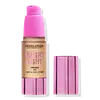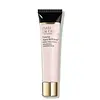What's inside
What's inside
 Key Ingredients
Key Ingredients

 Benefits
Benefits

 Concerns
Concerns

 Ingredients Side-by-side
Ingredients Side-by-side

Water
Skin ConditioningGlycerin
HumectantEthylhexyl Palmitate
EmollientButylene Glycol
HumectantMica
Cosmetic ColorantPolysorbate 60
EmulsifyingPolyacrylamide
Caprylic/Capric Triglyceride
MaskingPhenoxyethanol
PreservativeC13-14 Isoparaffin
EmollientCaprylyl Glycol
EmollientDisodium EDTA
Panthenol
Skin ConditioningEthylhexylglycerin
Skin ConditioningTocopheryl Acetate
AntioxidantParfum
MaskingAloe Barbadensis Leaf Juice
Skin ConditioningC9-11 Pareth-6
EmulsifyingSynthetic Fluorphlogopite
Tin Oxide
AbrasiveTocopherol
AntioxidantCitric Acid
BufferingSodium Benzoate
MaskingPotassium Sorbate
PreservativeSodium Sulfite
PreservativeCinnamyl Alcohol
PerfumingCI 77891
Cosmetic ColorantCI 77491
Cosmetic ColorantCI 77499
Cosmetic ColorantCI 77492
Cosmetic ColorantWater, Glycerin, Ethylhexyl Palmitate, Butylene Glycol, Mica, Polysorbate 60, Polyacrylamide, Caprylic/Capric Triglyceride, Phenoxyethanol, C13-14 Isoparaffin, Caprylyl Glycol, Disodium EDTA, Panthenol, Ethylhexylglycerin, Tocopheryl Acetate, Parfum, Aloe Barbadensis Leaf Juice, C9-11 Pareth-6, Synthetic Fluorphlogopite, Tin Oxide, Tocopherol, Citric Acid, Sodium Benzoate, Potassium Sorbate, Sodium Sulfite, Cinnamyl Alcohol, CI 77891, CI 77491, CI 77499, CI 77492
Water
Skin ConditioningMethyl Trimethicone
Skin ConditioningButylene Glycol
HumectantGlycerin
HumectantGlycereth-26
HumectantPropanediol
SolventDimethicone
EmollientSodium Hyaluronate
HumectantTocopheryl Acetate
AntioxidantSqualane
EmollientHelianthus Annuus Seed Extract
Skin ConditioningPropylene Glycol Dicaprate
EmollientCucumis Sativus Fruit Extract
EmollientSimmondsia Chinensis Seed Oil
EmollientHaberlea Rhodopensis Leaf Extract
Skin ConditioningBeta Vulgaris Root Extract
Skin ConditioningPalmitoyl Tripeptide-1
Skin ConditioningArtemia Extract
Skin ConditioningNymphaea Alba Root Extract
Skin ConditioningHordeum Vulgare Extract
EmollientPolygala Senega Root Extract
RefreshingBeta Vulgaris Extract
Skin ProtectingCaffeine
Skin ConditioningPhenyl Trimethicone
Skin ConditioningAscorbyl Glucoside
AntioxidantBetaine
HumectantTrehalose
HumectantEthylhexyl Palmitate
EmollientCetyl PEG/PPG-10/1 Dimethicone
EmulsifyingLauryl PEG-9 Polydimethylsiloxyethyl Dimethicone
Skin ConditioningCholesterol
EmollientMethyldihydrojasmonate
MaskingMethicone
EmollientCaprylyl Glycol
EmollientTriticum Vulgare Germ Extract
Skin ConditioningYeast Extract
Skin ConditioningTribehenin
EmollientGlucose
HumectantSucrose
HumectantTin Oxide
AbrasiveDimethicone/PEG-10/15 Crosspolymer
Dipropylene Glycol
HumectantPEG-75
HumectantSilica Dimethyl Silylate
EmollientSorbitan Isostearate
EmulsifyingPolysilicone-11
Synthetic Fluorphlogopite
Xanthan Gum
EmulsifyingPolyquaternium-51
Skin ConditioningNylon-12
Citric Acid
BufferingSodium Chloride
MaskingDisodium EDTA
Sodium Citrate
BufferingChlorphenesin
AntimicrobialPotassium Sorbate
PreservativePhenoxyethanol
PreservativeMica
Cosmetic ColorantCI 77891
Cosmetic ColorantCI 77491
Cosmetic ColorantCI 77163
Cosmetic ColorantWater, Methyl Trimethicone, Butylene Glycol, Glycerin, Glycereth-26, Propanediol, Dimethicone, Sodium Hyaluronate, Tocopheryl Acetate, Squalane, Helianthus Annuus Seed Extract, Propylene Glycol Dicaprate, Cucumis Sativus Fruit Extract, Simmondsia Chinensis Seed Oil, Haberlea Rhodopensis Leaf Extract, Beta Vulgaris Root Extract, Palmitoyl Tripeptide-1, Artemia Extract, Nymphaea Alba Root Extract, Hordeum Vulgare Extract, Polygala Senega Root Extract, Beta Vulgaris Extract, Caffeine, Phenyl Trimethicone, Ascorbyl Glucoside, Betaine, Trehalose, Ethylhexyl Palmitate, Cetyl PEG/PPG-10/1 Dimethicone, Lauryl PEG-9 Polydimethylsiloxyethyl Dimethicone, Cholesterol, Methyldihydrojasmonate, Methicone, Caprylyl Glycol, Triticum Vulgare Germ Extract, Yeast Extract, Tribehenin, Glucose, Sucrose, Tin Oxide, Dimethicone/PEG-10/15 Crosspolymer, Dipropylene Glycol, PEG-75, Silica Dimethyl Silylate, Sorbitan Isostearate, Polysilicone-11, Synthetic Fluorphlogopite, Xanthan Gum, Polyquaternium-51, Nylon-12, Citric Acid, Sodium Chloride, Disodium EDTA, Sodium Citrate, Chlorphenesin, Potassium Sorbate, Phenoxyethanol, Mica, CI 77891, CI 77491, CI 77163
Ingredients Explained
These ingredients are found in both products.
Ingredients higher up in an ingredient list are typically present in a larger amount.
Butylene Glycol (or BG) is used within cosmetic products for a few different reasons:
Overall, Butylene Glycol is a safe and well-rounded ingredient that works well with other ingredients.
Though this ingredient works well with most skin types, some people with sensitive skin may experience a reaction such as allergic rashes, closed comedones, or itchiness.
Learn more about Butylene GlycolCaprylyl Glycol is a humectant and emollient, meaning it attracts and preserves moisture.
It is a common ingredient in many products, especially those designed to hydrate skin. The primary benefits are retaining moisture, skin softening, and promoting a healthy skin barrier.
Though Caprylyl Glycol is an alcohol derived from fatty acids, it is not the kind that can dry out skin.
This ingredient is also used as a preservative to extend the life of products. It has slight antimicrobial properties.
Learn more about Caprylyl GlycolCi 77491 is also hydrated iron III oxide. It's sole purpose is to give a red/pink hue to products.
Iron III oxides are classified as inorganic chemicals for coloring.
Synthetically created Ci 77491 is considered safer than those naturally found. This is because the synthetically created version may contain less impurities. Iron oxides are generally non-toxic and non-allergenic.
Learn more about CI 77491Ci 77891 is a white pigment from Titanium dioxide. It is naturally found in minerals such as rutile and ilmenite.
It's main function is to add a white color to cosmetics. It can also be mixed with other colors to create different shades.
Ci 77891 is commonly found in sunscreens due to its ability to block UV rays.
Learn more about CI 77891Citric Acid is an alpha hydroxy acid (AHA) naturally found in citrus fruits like oranges, lemons, and limes.
Like other AHAs, citric acid can exfoliate skin by breaking down the bonds that hold dead skin cells together. This helps reveal smoother and brighter skin underneath.
However, this exfoliating effect only happens at high concentrations (20%) which can be hard to find in cosmetic products.
Due to this, citric acid is usually included in small amounts as a pH adjuster. This helps keep products slightly more acidic and compatible with skin's natural pH.
In skincare formulas, citric acid can:
While it can provide some skin benefits, research shows lactic acid and glycolic acid are generally more effective and less irritating exfoliants.
Most citric acid used in skincare today is made by fermenting sugars (usually from molasses). This synthetic version is identical to the natural citrus form but easier to stabilize and use in formulations.
Read more about some other popular AHA's here:
Learn more about Citric AcidDisodium EDTA plays a role in making products more stable by aiding other preservatives.
It is a chelating agent, meaning it neutralizes metal ions that may be found in a product.
Disodium EDTA is a salt of edetic acid and is found to be safe in cosmetic ingredients.
Learn more about Disodium EDTAEthylhexyl Palmitate, also known as octyl palmitate, is created from 2-ethylhexyl alcohol and palmitic acid. It is a fatty acid ester.
The fatty acid content of Ethylhexyl Palmitate makes it an emollient. Emollients help soften and hydrate your skin by trapping moisture within.
Ethylhexyl Palmitate is also used to help improve the texture of cosmetics. It helps other ingredient dissolve in products and help disperse ingredients more evenly.
You'll likely find this ingredient in sunscreen, as it is often used to mix UV-blocking ingredients such as avobenzone and ethylhexyl triazone.
It can also help stabilize the fragrances in a product as a fragrance fixative.
Ethylhexyl Palmitate can be used to substitute mineral oil.
Due to its high fatty acid content, it may not be fungal-acne safe.
Learn more about Ethylhexyl PalmitateGlycerin is already naturally found in your skin. It helps moisturize and protect your skin.
A study from 2016 found glycerin to be more effective as a humectant than AHAs and hyaluronic acid.
As a humectant, it helps the skin stay hydrated by pulling moisture to your skin. The low molecular weight of glycerin allows it to pull moisture into the deeper layers of your skin.
Hydrated skin improves your skin barrier; Your skin barrier helps protect against irritants and bacteria.
Glycerin has also been found to have antimicrobial and antiviral properties. Due to these properties, glycerin is often used in wound and burn treatments.
In cosmetics, glycerin is usually derived from plants such as soybean or palm. However, it can also be sourced from animals, such as tallow or animal fat.
This ingredient is organic, colorless, odorless, and non-toxic.
Glycerin is the name for this ingredient in American English. British English uses Glycerol/Glycerine.
Learn more about GlycerinMica is a naturally occurring mineral used to add shimmer and color in cosmetics. It can also help improve the texture of a product or give it an opaque, white/silver color.
Serecite is the name for very fine but ragged grains of mica.
This ingredient is often coated with metal oxides like titanium dioxide. Trace amounts of heavy metals may be found in mica, but these metals are not harmful in our personal products.
Mica has been used since prehistoric times throughout the world. Ancient Egyptian, Indian, Greek, Roman, Aztec, and Chinese civilizations have used mica.
Learn more about MicaPhenoxyethanol is a preservative that has germicide, antimicrobial, and aromatic properties. Studies show that phenoxyethanol can prevent microbial growth. By itself, it has a scent that is similar to that of a rose.
It's often used in formulations along with Caprylyl Glycol to preserve the shelf life of products.
Potassium Sorbate is a preservative used to prevent yeast and mold in products. It is commonly found in both cosmetic and food products.
This ingredient comes from potassium salt derived from sorbic acid. Sorbic acid is a natural antibiotic and effective against fungus.
Both potassium sorbate and sorbic acid can be found in baked goods, cheeses, dried meats, dried fruit, ice cream, pickles, wine, yogurt, and more.
You'll often find this ingredient used with other preservatives.
Learn more about Potassium SorbateSynthetic Fluorphlogopite is the synthethic version of mica. It consists of fluorine, aluminum and silicate.
Synthetic Fluorphlogopite is used to add volume to products.
It is considered non-irritating on the skin.
Learn more about Synthetic FluorphlogopiteTin Oxide is an inorganic oxide used to add opacity and volume to a product. In nature, it is already found in mineral form. The main ore of tin is an opaque and shiny mineral called casseterite.
Tin Oxide helps remove translucency in a product, or make it more opaque. Besides adding opacity, tin oxide is used for bulking to add volume.
Tocopheryl Acetate is AKA Vitamin E. It is an antioxidant and protects your skin from free radicals. Free radicals damage the skin by breaking down collagen.
One study found using Tocopheryl Acetate with Vitamin C decreased the number of sunburned cells.
Tocopheryl Acetate is commonly found in both skincare and dietary supplements.
Learn more about Tocopheryl AcetateWater. It's the most common cosmetic ingredient of all. You'll usually see it at the top of ingredient lists, meaning that it makes up the largest part of the product.
So why is it so popular? Water most often acts as a solvent - this means that it helps dissolve other ingredients into the formulation.
You'll also recognize water as that liquid we all need to stay alive. If you see this, drink a glass of water. Stay hydrated!
Learn more about Water